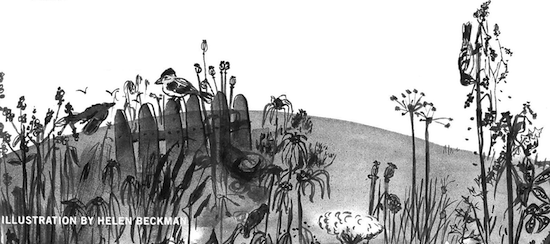Upright, well-mannered gardens, with tidy beds of manicured lettuce corseted by tightly clipped boxwood hedges, make me itch. I have a naughty mind that wants to scratch rank pigwood seed between all neat and trim rows. Give me a wild garden any day.
One of the most inspiring autumn gardens I ever saw was just such a wild patch growing in a deserted city lot in the heart of industrial West Berkeley. There, in the midst of upscale, gentrified businesses and a thumping lumberyard and sand factory, this forgotten garden dominated the landscape.
The garden was originally a market enterprise, designed to grow specialty organic produce for high-end purchase. This project, which had been a huge success at first, mysteriously went belly-up. The ripe garden crops were harvested for sale and the rest of the plot was abandoned, left to go to seed.
I found this garden in late September. It had been months since I had driven past the voluptuous beds of marketable rouge d’hiver lettuce and tricolored chilies from the Southwest. Now, that same garden was a thicket of weeds and tattered crops, all tangled up together.
I had never seen so many plants in seed at the same time. We let our garden weeds grow big at Green Gulch, cultivating them when they are most succulent for the yawning jaws of the compost pile. But we never let them go to seed. In this abandoned plot, every plant was bone dry and crackling with seed. Towering columns of woody Touchon carrots showered a storm of ripe seed onto the pavement and all of the gourmand weeds of the home garden—lamb’s quarters, chickweed, mallow, and Russian thistle—spat fat seed down onto the baked earth. The garden was alive with the call of hundreds of seed-eating birds, hanging upside-down on ripe stalks. Black-headed grosbeaks and white-crowned sparrows feasted with finches in the forgotten lot.
This urban patch of wildness worked on me for months. I’m an organic gardener who never leaves anything alone. I’m always tying up gangly sweet pea tendrils, or pulling out bolted bokchoy so we can plant more baby bokchoy. Sometimes I feel like a liontamer standing on a wobbly stool trying to whip back the snarling garden all around me. But after that feral city garden, wild thoughts cropped up in me with force. I felt my own fangs begin to grow, and my claws. I wanted to go to seed, too.
“Taming a wild thought is a wild thought,” says Zen Master Bankei. So for once, I didn’t try. Instead, I went home and surveyed our autumn garden. There was one particularly weedy bed of golden beets that we hadn’t gotten to. I decided to let it grow wild. In less than a month the weeds arched over the beets and covered the bed. I dug into that thicket now and then for months and pulled out extraordinary golden globes, up until the New Year and beyond. By March the beets remaining in this weedy patch had sent up their first ragged seed stalks. And just a few weeks ago I harvested ripe beet seed from this fierce stand.
If you have a garden or even a planter box packed with cherished crops, why not loosen your grip and let a corner of your territory run to seed? See what happens to you. Thoreau says that in wildness is the preservation of the world, yet we have so little untamed wildness left in our lives. So I rejoice in the victory of the feral tangle in downtown Berkeley and listen as the cultivated garden all around me cheers on the runaway beets and their weedy guardians. “Go to seed,” the tame and domesticated crops urge the golden beets, “Go to seed for all beings.”

Illustration by Helen Beckman.
Thank you for subscribing to Tricycle! As a nonprofit, we depend on readers like you to keep Buddhist teachings and practices widely available.